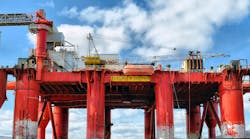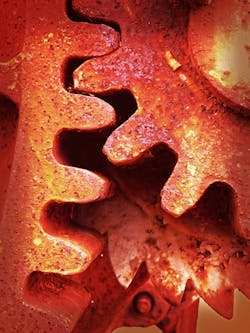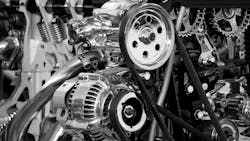Friction and wear pose enormous challenges to 21st Century mechanical and electromechanical systems. By one estimate, 6% of the gross national product is wasted through its impact. Tribology is the study of that phenomenon, and MIT Professional Education Professor, Dr. Nicholas Randall, is currently drawing engineers and students from around the globe to his course, Tribology: Friction, Wear, and Lubrication. What follows are his thoughts on how to bolster awareness of a field which, until recently, has lacked significant government and academic support.
The study of tribology is important, and yet most engineers don’t have a sufficient background in this area of study. An undergraduate engineering student gets perhaps an hour of instruction in tribology. Even engineers coming out of a material science or mechanical engineering course learn the basics, but not necessarily its real-world applications.
By one estimate, 6% of the gross national product is wasted due to friction and wear on 21st Century mechanical and electromechanical systems.
It is an important topic, and a reason why I wanted to participate in a class to help engineers find solutions. Many of those who attend are from the lubricant industries looking to solve specific problems that have arisen in their workplaces. That’s a very focused audience. It is important that a course covers more, but it isn’t possible to capture the broad range of tribology issues in a single class.
Some points I make are that the study of tribology really began in the ’60s and has matured over the years. It’s important because tribology relates to any sort of moving system, of which there are many in use today. Some may require high friction to work properly (e.g., brake pads) whilst others may have the longest lifetime if friction is reduced to a minimum and wear is prevented (e.g., a prosthetic hip joint).
This has led to the development of better materials and lubricants. The government of the United Kingdom commissioned a study, which put in the billions the annual cost from friction and wear on machines and automobile engines. This included the impact on auto gas mileage and the environment. Now, new coatings on engine machinery and auto components have produced more efficient engines and synthetic oils that don’t oxidize or degrade as quickly. These were major tribological innovations.
New coatings on engine machinery and automobile components have produced more efficient engines and synthetic oils that don’t oxidize or degrade as quickly.
Tribology isn’t just about automotive, but really anything that moves. Cutting and drilling tools and bits are now getting tougher coatings to make them last longer. An example is the massive drill used for drilling for oil in the ocean. Changing a drill on an oil rig costs millions of dollars. So if you can make it last longer, the commercial implications are huge. Another example at the opposite end of the scale could be the improved coating on the miniature drilling bit used by a dentist.
In both these cases, we’re talking about traditional large system Tribology. I also give a lecture on Nano-Tribology that looks at very small-scale friction issues, which can be more challenging.
The size and scale of tribology is expansive. It is important to give students an idea of what the science is. Once they have a general idea, you can better direct them, or they can direct themselves, on how to use the science to improve their specific problem. For example, tribology is responsible for drills lasting longer, but also for contact lenses to be more comfortable. Today we’re looking at more comfortable, longer-lasting contact lenses due to new coatings that reduce friction between the lens and corneal tissue.
Advances in tribology are helping to extend the life of cutting and drilling tools. Considering it costs millions of dollars to change a drill on an oil rig in the ocean, the commercial implications are huge.
A new area of research has opened under the heading biotribology—the interaction of tribology with medicine and biology. This new area is improving the design and lubrication of devices inserted into the body, such as stents, catheters, brain valves, artificial hearts, prosthetic materials, and artificial hip or knee joint replacements.
Currently new hips and knees are supposed to last 15 years. In some cases they last a lot less because of wear on the contacting materials. If we can improve the material and reduce friction, we may be able to double that. So the implications for patient care are huge. In some cases, drugs can be inserted into the lubricants to ease discomfort during procedures done without general anesthesia.
You might hear terms like “solid-state computer” and think, computers don’t need lubrication. But friction and wear play a role in any moving system. For computer parts that still move, such as the hard disk which is spinning at 10,000 RPM or more—if debris gets on the disk and it gets worn, you begin losing data. There is also an atomic layer of lubricant on the disk. If it’s too thick, again, you lose data density as the read-write head is too far from the magnetic layers.
If you think this doesn’t matter because solid-state technology will take over, according to a study done by IHS Market, hard disks will dominate the market through 2021. This is mainly due to its higher storage densities and cheaper price. So tribology touches every area of our lives.
Tribology will continue to be important, but the reason this technology might not have been pursued is the cost. Ten years ago, only high-stress Formula One cars were using highly resistant coatings to reduce friction on components. Now even cheaper cars have coated piston rings and other components. Beyond that it becomes very expensive.
How do we put state-of-the-art tribological advances in less expensive car models without vastly increasing the price? It’s not easy. But now the government is pushing for increased automobile efficiency and higher miles per gallon. We’re getting some traction in pushing Congress for more funding. And we’re seeing more interest in research by universities. This is all very good news.
As it affects 6% of our GDP, I am excited to teach this course at MIT and think it is a timely and valuable course.
Nicholas X. Randall, co-instructor of the MIT Professional Education course, Tribology, Friction, Wear, and Lubrication, is a Chartered Engineer (CEng MIM) and holds a BSc degree. He currently serves as lead scientist with Anton Paar. He has published extensively in the field of surface mechanical properties testing, especially related to scratch (adhesion) testing, nanoindentation, and tribology testing. He is chairman of ASTM committee G02.40, responsible for developing tribological test standards for non-abrasive wear. He is a member of MRS, ASM, ASTM, STLE, and The Institute of Materials (UK).




